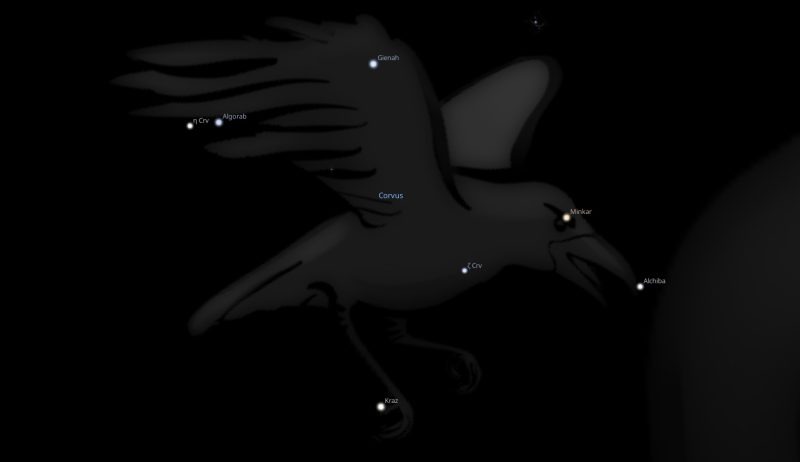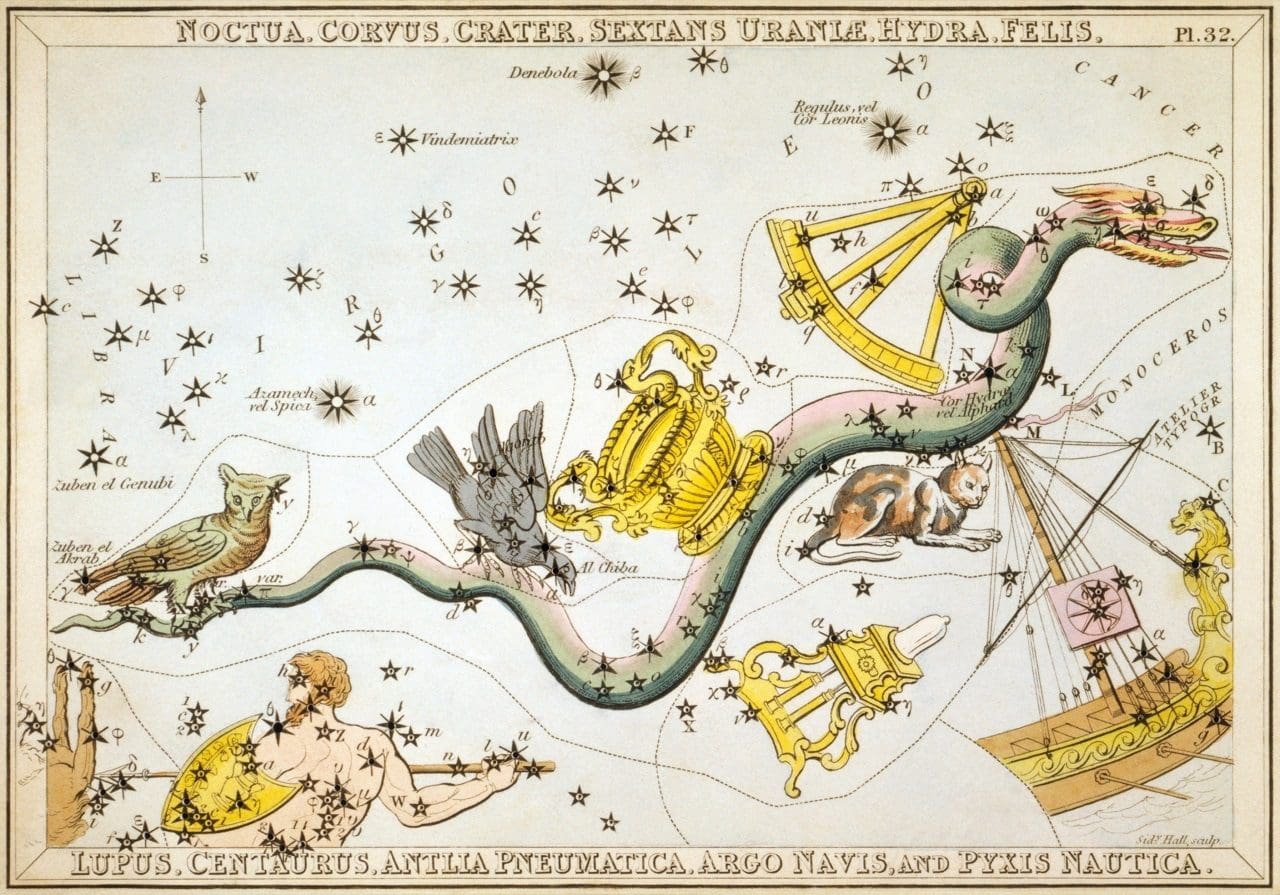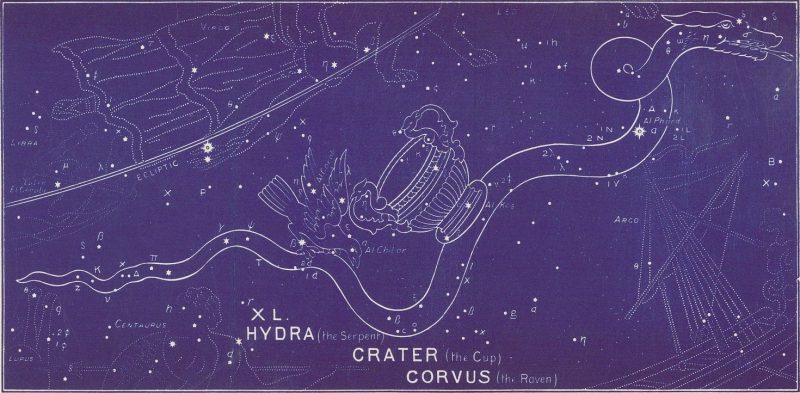FIXED STARS: Major Stars | 1000+ Stars | Constellations | About
Constellation Corvus the Crow is a southern constellation bordering Virgo, Crater and Hydra.Corvus is one of the 48 constellations listed by Ptolemy in the 2nd century and remains one of the 88 modern constellations. It spans 10 degrees of the zodiac in the Sign of Libra.
Abbreviation: Crv
Genitive: Corvi
Corvus Constellation Stars
| 2000 | 2050 | Star | Name | Sp. Class | Mag. | Orb |
|---|---|---|---|---|---|---|
| 10♎43 | 11♎25 | γ Crv | Gienah | B8 | 2.58 | 2°10′ |
| 11♎40 | 12♎22 | ε Crv | Minkar | K2 | 3.02 | 1°50′ |
| 12♎57 | 12♎57 | α Crv | Alchiba | F0 | 4.02 | 1°20′ |
| 13♎27 | 14♎09 | δ Crv | Algorab | B9 | 2.94 | 1°50′ |
| 13♎48 | 14♎30 | ζ Crv | Changsha | B8 | 5.20 | 1°00′ |
| 13♎49 | 14♎31 | η Crv | Zuoxia | F2 | 4.30 | 1°10′ |
| 17♎22 | 18♎04 | β Crv | Kraz | G5 | 2.65 | 2°10′ |
Corvus Astrology
Robson
Legend. Apollo gave a feast to Jupiter and requiring water sent the raven with a cup (CRATER) to fetch some. On his way the raven noticed a fig tree, and, resting there until the figs became ripe, feasted himself upon them until, remembering his errand and fearing the anger of Apollo, he picked up a snake (HYDRA) and on his return gave as an excuse that it had prevented him from filling the cup. Apollo ordained in punishment that the raven should never drink so long as figs were not ripe, and placed the crow, cup and snake in the heavens as a memorial.
Influence. According to Ptolemy, Corvus is like Mars and Saturn. It is said to give craftiness, greediness, ingenuity, patience, revengefulness, passion, selfishness, lying, aggressiveness, and material instincts, and sometimes causes its natives to become agitators. [1]
Noonan
Today called Corvus (Crv), this constellation has all the traditional attributes of Mercury, but with some distinct perversions! The sharp intelligence is blunted, and what passes for wisdom is superficial. Mercury is there, but any attempt to manifest its abilities ends in disaster. Ovid explained the phenomena by claiming Apollo punished the Raven for her unfaithfulness. Ptolemy asserts that the stars of the constellation portend storms, and some astrologers say it gives craftiness and greediness. [2]
Allen
Corvus was the Raven… Although now traversed by the 20th degree of south declination, 2000 years ago it lay equally on each side of the celestial equator. It contains only 15 naked-eye stars according to Argelander, — 26 according to Heis, — yet was a noted constellation with the Greeks and Romans, and always more or less associated with the Cup and with the Hydra, on whose body it rests… but while always so drawn, the three constellations for a long time have been catalogued separately.
The Greeks called it Κόραξ, Raven; and the Romans, Corvus. Manilius designating it as Phoebo Sacer Ales, and Ovid as Phoebeīus Ales, mythology having made the bird sacred to Phoebus Apollo in connection with his prophetic functions, and because he assumed its shape during the conflict of the gods with the giants.
Ovid, narrating in the Metamorphoses the story of Coronis, and of her unfaithfulness to Apollo, said that when the bird reported to his master this unwelcome news he was changed from his former silver hue to the present black.
Another version of the legend appears in the Fasti — viz., that the bird, being sent with a cup for water, loitered at a fig-tree till the fruit became ripe, and then returned to the god with a water-snake (adjacent Hydra) in his claws and a lie in his mouth, alleging the snake to have been the cause of his delay. In punishment he was forever fixed in the sky with the Cup and the Snake; and, we may infer, doomed to everlasting thirst by the guardianship of the Hydra over the Cup and its contents. From all this came other poetical names for our Corvus — Avis Ficarius, the Fig Bird; and Emansor, one who stays beyond his time; and a belief, in early folklore, that this alone among birds did not carry water to its young.
The Raven of Rome and Greece became Al Ghurāb in Arabia; but in earlier days four of its stars were Al ‘Arsh al Simāk al ‘Azal, the Throne of the Unarmed One, referring to the star Spica. These naturally have been considered β, γ, δ, and η; but Firuzabadi, as interpreted by Lach, said that they were θ, κ, ψ, and g; and the same stars were Al ‘Ajz al Asad, the Rump of the ancient Lion. Other early titles for the whole were Al Ajmāl, p181 the Camel, and Al Ḣibā‘, the Tent; this last generally qualified by Yamaniyyah, the Southern, to distinguish it from that in Auriga. Instead of Ajmāl, Hyde quoted, from the Mudjizat, Ahmal, or Ḥamal, the Ram, but this does not seem probable here.
As these stars were utilized by the Arabs in forming their exaggerated Asad, so also were they by the Hindus in the immense Praja-pāti, of which they marked the hand, — this title being duplicated for Orion, and much better known for that constellation. The head of the figure was marked by Citrā, our Spica, and the thighs by the two Viçākhas, α and β Librae; while the Anuradhas, β, δ, and π Scorpii, formed Praja-pāti’s standing-place. Incongruously enough, they considered Nishtya, or Svati, — our star Arcturus, — as the heart; but as this was far out of the proper place for that organ, Professor Whitney substituted ι, κ, and λ Virginis of the manzil and sieu.
The Avesta mentions a stellar Raven, Eorosch; but how, if at all, this coincided with ours is unknown; although Hewitt thinks that our Corvus, under the title Vanant, marked the western quarter of the earliest Persian heavens.
Nor is the reason for the association of Corvus with Hydra evident, although there is a Euphratean myth, from far back of classical days, making it one of the monster ravens of the brood of Tiāmat that Hydra represented; and upon a tablet appears a title that may be for Corvus as the Great Storm Bird, or Bird of the Desert, to which Tiāmat gave sustenance, just as Aratos described Κόραξ pecking the folds of the Hydra. The prominent stars of Corvus have otherwise been identified with the Akkadian Kurra, the Horse.
The Hebrews knew it as ‘Ōrebh, or Ōrev, the Raven; and the Chinese, as a portion of their great stellar division the Red Bird, while its individual stars were an Imperial Chariot ruling, or riding upon, the wind. [3]
Bullinger
Here is the final scene of judgment. We have had Zeeb, the Wolf; now we have Oreb, the Raven. Her-na is its name in the Denderah Zodiac. Her, means the enemy; and Na, means breaking up or failing. That is to say, this scene represents the breaking up of the enemy.
There are nine stars (the number of judgment) in this constellation. The bright star α (in the eye) is called Al Chibar (Arabic), joining together, from the Hebrew Chiba (Num 23:8), which means accursed. This star, then, tells of the curse inflicted. The star β (in the right wing) is called Al Goreb (Arabic), from Hebrew Oreb, the Raven. A third star is named Minchar al Gorab (Arabic), and means the Raven tearing to pieces. [1]
References
- Fixed Stars and Constellations in Astrology, Vivian E. Robson, 1923, p.40-41.
- Fixed Stars and Judicial Astrology, George Noonan, 1990, p.71-72.
- Star Names, Their Lore and Meaning, Richard Hinckley Allen, 1899, p.179-182.
- The Witness of the Stars, E. W. Bullinger, 1893, CORVUS (the Raven).


